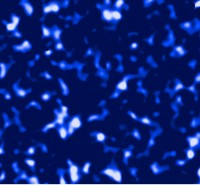Astronomers reach new frontiers of dark matter

Astronomers have mapped dark matter on the largest scale ever observed. The School's Dr Catherine Heymans and Associate Professor Ludovic Van Waerbeke of the University of British Columbia, Vancouver, Canada, will present the results today to the American Astronomical Society meeting in Austin, Texas. Their findings reveal a Universe comprising an intricate cosmic web of dark matter and galaxies spanning more than one billion light years.
An international team of researchers lead by Van Waerbeke and Heymans achieved their results by analysing images of about 10 million galaxies in four different regions of the sky. They studied the distortion of the light emitted from these galaxies, which is bent as it passes massive clumps of dark matter during its journey to Earth.
Their project - known as the Canada-France-Hawaii Telescope Lensing Survey (CFHTLenS) - uses data from the Canada-France-Hawaii Telescope Legacy Survey. This accumulated images over five years using the wide field imaging camera MegaCam, a 1 degree by 1 degree field-of-view, 340 Megapixel camera on the CFHT in Hawaii.
Galaxies included in the survey are typically six billion light years away. The light captured by the images used in the study was emitted when the Universe was six billion years old – roughly half the age it is today.
The team’s result has been suspected for a long time from studies based on computer simulations, but was difficult to verify owing to the invisible nature of dark matter. This is the first direct glimpse of dark matter on large scales showing the cosmic web in all directions.
“By analysing light from the distant Universe, we can learn about what it has travelled through on its journey to reach us. We hope that by mapping more dark matter than has been studied before, we are a step closer to understanding this material and its relationship with the galaxies in our Universe.”
Dr Catherine Heymans, School of Physics & Astronomy
Dr Thomas Kitching is the Cosmology Working Group coordinator, based in the School's Institute for Astronomy. "The dark matter map we have produced looks back over 75% of the age of the Universe, to a time when it was very different to today. By tracking the evolution of the Universe over cosmic time, the team at Edinburgh will investigate how dark energy has come to dominate the present day Universe.
"Over the next few months we will be using this data to map the evolution of the expansion of the Universe and learn about dark energy, which is causing the expansion of the Universe to accelerate. We will test theories of gravity itself to determine if Einstein's general relativity is correct or not. We will also use it to determine the properties of neutrinos, ghostly particles that interact with normal matter only very weakly."
The research was supported by the European Research Council, Natural Sciences and Engineering Research Council of Canada, the Canadian Institute for Advanced Research and the Canadian Astronomy Data Centre.

